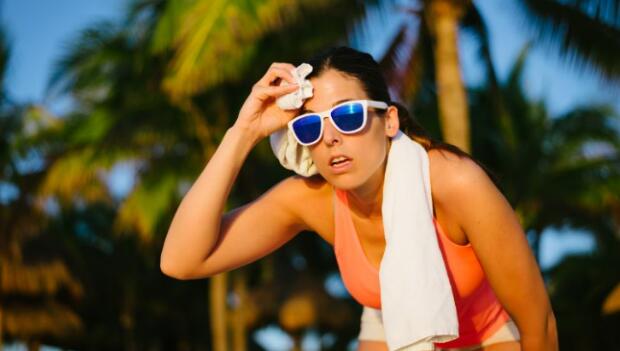
1. Acclimatize
It takes time for your body to adjust to hot and/or humid weather. Just because you can run a 10-miler at an 8-minute pace, doesn't mean you can do the same when the dog days of summer approach. The American Running and Fitness Association recommends that on your first run in the heat, you should cut your intensity by 65 to 75 percent. Then over the next 10 days, slowly build back to your previous level.
2. Check the Index
Before heading out on your run, it's a good idea to check the air quality index and the heat index. If the air quality index is code orange, and you're sensitive to air pollution and/or have upper respiratory problems, you may not want to run. If it's code red, it's not suitable for anyone to run.
The Heat Index tells you what the temperature feels like when combining the air temperature and the relative humidity. For example, if the air temperature is 90 degrees and the relative humidity is 70 percent, then it's going to feel as if it's 106 degrees. Ouch! These are not good running conditions.
The weather section of your local TV station's website usually provides air quality index and heat index information for your area.
3. Hydrate! Hydrate! Hydrate!
Many runners remember to rehydrate after their run and some consume water or sports drink during the run, but it's even more important to be well-hydrated before you run. As a rule of thumb, drinking 16 oz. of water two hours before your run will ensure good hydration levels and give the water time to pass through your system so you don't have to make any pit stops during your run.
Hydration during your run depends on the temperature and the length of your run. If you're running 4 miles or less, you probably won't need to carry any water with you. If you're running longer than 4 miles you may need to wear a hydration belt or stash some water/sports drink along your route, especially if it's hot and humid.
Don't wait until you feel thirsty to drink. If you're thirsty, that means you're already low on fluids. Also, as you age, your thirst mechanism isn't as efficient and your body may in the early stages of dehydration and you may not even feel thirsty.
More: The Truth About Hydration in the Heat
For the first 45 to 60 minutes, water is fine. After 60 minutes, you'll need to start using a sports drink or supplementing with a sports gel or a salty food such as pretzels. After 60 minutes (and sometimes sooner if it's really hot and you sweat a lot), you begin to deplete vital electrolytes (i.e., sodium, potassium, etc.). Sodium is needed in order for your body to absorb the fluids you're ingesting. Ever get that sloshing feeling late in a run? That's probably because your body is low on sodium and not able to absorb the fluids you're drinking, so it just sits in your stomach and sloshes around not doing you any good. Depleted potassium levels can increase your chances of experiencing muscle cramps.
After your run, you need to replace the water you've lost. A good way to check this is to weigh before your run and then weigh after your run. Drink 16 oz. of water for every pound lost. After you do the weigh-in a few times, you'll get a feel for how much rehydration you need depending on how much you sweat on your run.
On a hot long run, pack an extra bottle of water. Don't drink this one. Instead, during the run periodically pour a little of the water on your head. This actually helps increase the evaporation-cooling effect.
4. Know the Warning Signs
Dehydration occurs when your body loses too much fluid. This can happen when you stop drinking water or lose large amounts of fluid through diarrhea, vomiting, sweating, or exercise. Not drinking enough fluids can cause muscle cramps. When you're dehydrated, you may feel faint, experience nausea and/or vomiting, have heart palpitations, and/or experience lightheadedness.
Runners also need to be aware of the signs of severe dehydration such as heat exhaustion and heatstroke, not only for yourself, but so you'll be able to identify the symptoms if a fellow runner is experiencing heat-related problems.



